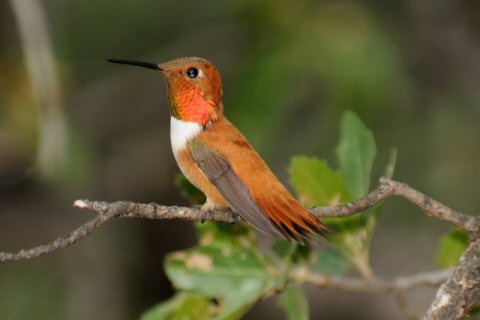

Rufous HummingbirdSelasphorus rufus | |
|
Rufous Hummingbirds breed in the Pacific Northwest, western Canada, and in southern Alaska. It is the most regular species found in Louisiana during the winter months, with as many as 66% of the individuals banded each year being identified as Rufous Hummingbirds. The first member of this species found in the state was captured in the senate chamber of the Capitol building in February 1934! Records extend from late July until late April, with peak abundance in December, January, and February. Gardens at favored locations have hosted as many as 10 individuals of this species at one time. There are reports from nearly all sections of the state. These birds are known for their feisty demeanor, making for a lively winter. Banding studies reveal that many of them return for subsequent winters, usually to the same site, 8 years in a couple of cases. However, a few choose different sites the next year for unknown reasons. Adult Male: The crown, nape, and back are bright rusty brown, often with a scattering of glittering green feathers. The crown can be green as well. Very rarely, the crown and back are almost completely green. The gorget [throat] is bright, iridescent reddish orange, changing to greenish or yellow depending upon the angle from which light strikes it. The wings are brownish black. The underparts are creamy white with a heavy wash of rufous coloration on the sides, flanks, and undertail coverts. The tail feathers are bright rufous at the base with more or less extensive black tips. The tip of each feather tapers to a blunt point. The center feathers are the longest with each succeeding feather being slightly shorter. A distinct notch is present on the second from center tail feather. The bill is black and about as long as the head. Adult Female: The crown, nape, and back are bright, glittering bronze green. The throat is white with heavy spotting or streaking of green and with a central spot or triangle of iridescent reddish orange, sometimes covering half the throat. The wings are brownish black The underparts are creamy white with a heavy wash of rufous coloration on the sides, flanks, and undertail coverts. These colors become much more rich and vibrant as the bird becomes older. The central tail feathers are the same bronze green as the back with a varying amount of rufous at the base and with a blackish tip. The remaining tail feathers are rufous at the base with a broad black band and the outer three on each side have white tips. The central tail feathers are the longest with each succeeding feather being shorter, giving the tail a rounded shape. The bill is black and slightly longer than the head. Immature Male: This plumage closely resembles that of the adult female except that the central tail feathers are mostly rufous and the rump is often rufous. As fall and winter progress, rufous feathers replace green ones until the back is mostly rusty brown like that of the adult male. The throat is heavily streaked or spotted with green. A few to many iridescent reddish orange feathers may be present on the throat, at times forming a central spot. Immature Female: This plumage closely resembles that of the adult female except that the colors of the flanks and undertail coverts are paler. The throat shows little streaking or spotting and the central spot of iridescent color on the throat is small or absent. The tail feathers may show less rufous coloration than those of an adult. |
 Adult male Rufous Hummingbird |